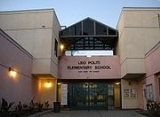
Leo Politi
Encyclopedia

Childhood
Politi was the youngest of two children, born Atiglio Leoni Politi on November 21, 1908, to Lodovico Politi and Mary Cazzola. Politi’s sister, Marie Therese, was two years older.Leo Politi’s life was the stuff that picture books are made of. He was transported to Italy
Italy
Italy , officially the Italian Republic languages]] under the European Charter for Regional or Minority Languages. In each of these, Italy's official name is as follows:;;;;;;;;), is a unitary parliamentary republic in South-Central Europe. To the north it borders France, Switzerland, Austria and...
at the age of seven — in an “Indian Chief suit,” via transcontinental railroad and ocean liner — and grew up, constantly drawing, in his mother’s native village of Broni near Milan
Milan
Milan is the second-largest city in Italy and the capital city of the region of Lombardy and of the province of Milan. The city proper has a population of about 1.3 million, while its urban area, roughly coinciding with its administrative province and the bordering Province of Monza and Brianza ,...
.
Lodovico left the family to take a job as a cobbler in Piacenza. Marie went to live with a poor aunt who operated a roadside inn. Politi was placed in a boarding home with an elderly woman and her daughter. Politi loved Broni, a deep affection that remained for the rest of his life. In Broni he began to develop his artistic sense, drawing sketches of village life.
By 1920 the Politis reunited and moved to London
London
London is the capital city of :England and the :United Kingdom, the largest metropolitan area in the United Kingdom, and the largest urban zone in the European Union by most measures. Located on the River Thames, London has been a major settlement for two millennia, its history going back to its...
where Politi was exposed to the culture and cosmopolitan lifestyle that Broni could never offer. On weekends, Leo and Marie packed a lunch basket and along with hundreds of other poor children lined up at a London theater to watch live shows and Charlie Chaplin
Charlie Chaplin
Sir Charles Spencer "Charlie" Chaplin, KBE was an English comic actor, film director and composer best known for his work during the silent film era. He became the most famous film star in the world before the end of World War I...
films. Politi devoured everything that London had to offer a boy. He wandered through the city's museums to view the works of Vincent van Gogh
Vincent van Gogh
Vincent Willem van Gogh , and used Brabant dialect in his writing; it is therefore likely that he himself pronounced his name with a Brabant accent: , with a voiced V and palatalized G and gh. In France, where much of his work was produced, it is...
and other masters.
After one year, the Politi family returned to Broni where Leo began studying art on a six-year scholarship at the Superior Institute of Fine Arts—also known as the National Art Institute—at the Royal Palace at Monza near Milan.
Early career
In 1931, Politi, at the age of 22, left Italy for California. Passing through the Panama CanalPanama Canal
The Panama Canal is a ship canal in Panama that joins the Atlantic Ocean and the Pacific Ocean and is a key conduit for international maritime trade. Built from 1904 to 1914, the canal has seen annual traffic rise from about 1,000 ships early on to 14,702 vessels measuring a total of 309.6...
he discovered the exotic beauty of Central America
Central America
Central America is the central geographic region of the Americas. It is the southernmost, isthmian portion of the North American continent, which connects with South America on the southeast. When considered part of the unified continental model, it is considered a subcontinent...
. He sketched the things that he saw and small stories began to bubble up within him.
He was attracted to the Mayan culture of the region and developed a palette that served as his core of colors throughout the 1930s and '40s. Politi later wrote of his technique: “(I) developed an ochre yellow, burnt sienna and a number of brown tints symbolic of the warmth and earthy qualities of the life and vegetation of the tropical Central American jungle. I also used a lively blue-green symbolic of the water, sky and in small spots for precious stones used then in their ornaments as jade – all elements inherent to the Maya civilization.”
Artist Buckley Mac-Gurrin, an art critic for the literary film magazine Script published by writer and artist Rob Wagner, wrote in a cover story of Politi in 1940 that “Leo became proficient in the use of many media – oil, watercolor, wood-carving, wood engraving, lithography, book illustration; he had a very fine artistic education. His training was modern as opposed to academic; it tended to develop originality rather than subservient to the art forms of bygone eras. His own artistic philosophy drew him toward the genuine and the earthy; toward people whose contact with the soil was still fresh, intimate, satisfying.”
Politi arrived in Los Angeles, California
Los Angeles, California
Los Angeles , with a population at the 2010 United States Census of 3,792,621, is the most populous city in California, USA and the second most populous in the United States, after New York City. It has an area of , and is located in Southern California...
, in October 1931 and two years later he married Helen Fontes.
Olvera Street
Politi began sketching and painting from a regular spot on Olvera StreetOlvera Street
Olvera Street is in the oldest part of Downtown Los Angeles, California, and is part of the El Pueblo de Los Angeles Historic Monument. Many Latinos refer to it as "La Placita Olvera." Circa 1911 it was described as Sonora Town....
in downtown Los Angeles, where he sketched tourists and sold drawings alongside potters, weavers and other artisans-in-residence. Politi’s affection for the Mexican-Americans and their folkways was genuine; an affinity. Most especially, as a devout Catholic, at home with Italian saints, he responded to Mexican ritual. Children — natural, spontaneous children — he loved without reserve or distinction. Drawing Mexican children, for magazines and books, gave him an American career and a professional identity.
He painted a mural on Olvera Street "The Blessing of the Animals", where he depicted a tradition of Catholicism
Catholicism
Catholicism is a broad term for the body of the Catholic faith, its theologies and doctrines, its liturgical, ethical, spiritual, and behavioral characteristics, as well as a religious people as a whole....
in remembrance of St. Francis of Assisi's love for all creatures. In the mural, men, women and children are walking their animals to get blessed.
During the 1930s he worked in oils, watercolors and wood sculptures. His best work was probably gouache
Gouache
Gouache[p], also spelled guache, the name of which derives from the Italian guazzo, water paint, splash or bodycolor is a type of paint consisting of pigment suspended in water. A binding agent, usually gum arabic, is also present, just as in watercolor...
on paper with variations of the theme of mother and child. He also focused on Mexican pueblo scenes, religious ceremonies and customs, dancers and mischievous children. His palette was generally the same: ochre yellow, burnt sienna and brown tints that to him defined the Mayan civilization.
His exhibits included the watercolor “Peons Asleep” and his sculpture “Mother and Child” at the Awards for the Ninth annual Exhibition of Southern California Art in 1937 in San Diego, California
San Diego, California
San Diego is the eighth-largest city in the United States and second-largest city in California. The city is located on the coast of the Pacific Ocean in Southern California, immediately adjacent to the Mexican border. The birthplace of California, San Diego is known for its mild year-round...
. In oil, Politi exhibited “Two Women and a Child.”
During the same year at the 18th annual Exhibition of Paintings and Sculptures at the Los Angeles Museum in Exposition Park
Exposition Park
Exposition Park is the name of more than one place:*Exposition Park - a neighborhood in south Dallas, Texas*Exposition Park - A former baseball park in Kansas City...
, Politi's wood sculpture “Pedro and Pepa” and watercolor “Market Scene” were exhibited. A year later “Pedro and Pepa” was displayed again at the 10th annual Southern California Art Exhibition at the Fine Arts Gallery in San Diego.
A one-man show at Alma Reed
Alma Reed
Alma Marie Sullivan Reed was an American journalist. While working in Mexico in the 1920s, she fell in love with the governor of Yucatán, Felipe Carrillo Puerto; however, he was assassinated a few days before their planned marriage. The ballad "Peregrina" is based on their romance...
’s Delphic Studios in New York City
New York City
New York is the most populous city in the United States and the center of the New York Metropolitan Area, one of the most populous metropolitan areas in the world. New York exerts a significant impact upon global commerce, finance, media, art, fashion, research, technology, education, and...
in 1937 ultimately helped lead him into a career as a children's author and illustrator on Latin themes.
His first book was “Little Pancho,” the illustrated story of a defiant, if not naughty, little Mexican boy on an adventure. Published in 1938, “Little Pancho” forever steered him onto the path as a children’s author. It also attracted the attention of the left-leaning Script magazine, in which Politi became the magazine’s art editor, and a smaller pacifist publication, Freedom, published by Prynce Hopkins
Prynce Hopkins
Prynce Hopkins , who was born Prince Charles Hopkins, was an American Socialist, pacifist and author of numerous psychology books and periodicals...
.
As war approached, Politi turned to political themes and often used his characters—Pancho, Lupita and Rosa—on the pages of Script and Freedom to convey pacifism in the face of war. His artwork reflected a multiculturalism
Multiculturalism
Multiculturalism is the appreciation, acceptance or promotion of multiple cultures, applied to the demographic make-up of a specific place, usually at the organizational level, e.g...
that was rarely seen in the era.
Early Books
He also illustrated “The Least One” by Ruth Sawyer in 1941, “Aqui se Habla Espanol” by Margarita Lopez and Esther Brown in 1942 and “Angelo, the Naughty One” by Helen Garrett in 1944. In 1944, he illustrated “Stories from the Americas.” It marked a distinct departure from Politi's early impressionist, cubist and art deco styles to a softer and less dark, gritty execution that typified his later work. The softer tones and themes continued in all of his future books. Multiculturalism continued to be an overriding theme, but was not overtly political as seen in his magazine work.Recognition
In 1980, a branch of the Fresno Public Library was named for him, and in 1991, the Leo Politi Elementary School was dedicated to him in Koreatown, a neighborhood in the Mid-Wilshire district of the City of Los Angeles. There is also a Leo Politi Square in Echo Park, where he lived for many years.Leo Politi's son, Paul Leo Politi, wrote the hit song, Those Oldies But Goodies (Remind Me Of You), recorded by Little Caesar and the Romans in 1961. Politi and Helen Fontes also had a daughter, Suzanne Bischof.
Works
- Pedro, the Angel of Olvera Street (1946) a Caldecott Honor book
- Juanita (1948)
- Song of the Swallows (1950), Caldecott MedalCaldecott MedalThe Caldecott Medal is awarded annually by the Association for Library Service to Children , a division of the American Library Association, to the artist of the most distinguished American picture book for children published that year. The award was named in honor of nineteenth-century English...
- A Boat for Peppe (1960)
- Bunker Hill, Los Angeles: Reminiscences of Bygone Days (1964)
- Piccolo's Prank (1965)
- Moy Moy (1960)
- Mr. Fong's toy shop (1978)
- "The Three Miracles" (1946)

